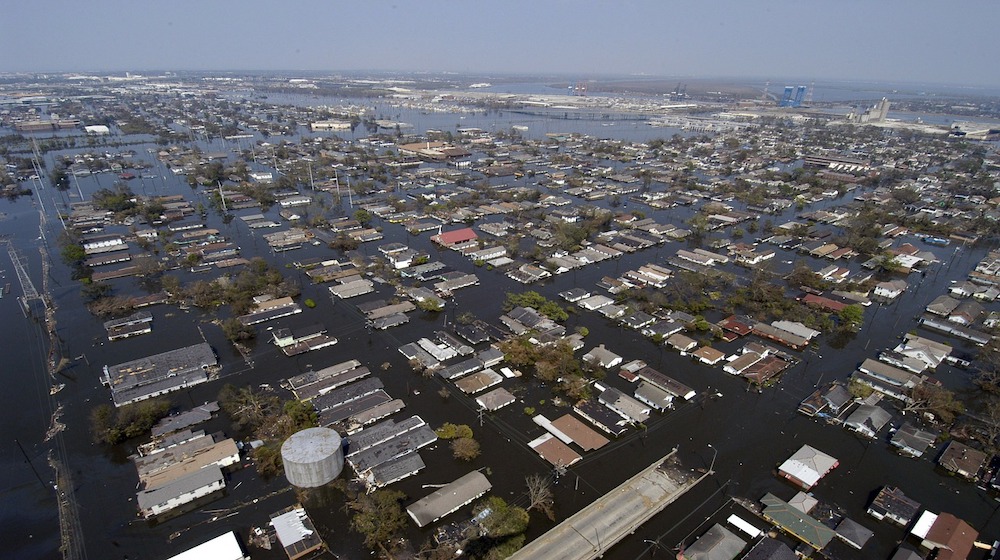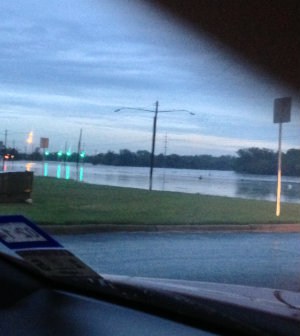Featured Articles
What Is The Real Cost Of Flooding?

The flooding in Colorado points out a very dangerous flaw in most Americans survival plans.
The majority of people only know that they live in a floodplain, if their insurance requires them to purchase flood insurance. Otherwise most people will take up a “why bother” mentality.
I was told I was absolutely safe from a flood by my insurance agent… but after a little research, I found out that I am only about 1000 yards from the edge of a 100 year floodplain.
The real key here is that the term “100 year flood” is a bogus number, used only by insurance agencies to determine your risk factor for filing a claim…
These “100 year floods” are actually more likely to occur every 30 years (the typical term for a normal home mortgage) and just because you live outside of one of these designated areas doesn't mean you are safe…
This article below found in the LA times, only highlights how unsafe we really are:
Wretched weather continued to hamper rescue efforts in Colorado on Sunday as officials released damage estimates illustrating the magnitude of the disaster.
By the numbers, here's some analysis of what we know about Colorado's floods, along with what we don't:
Number of fatalities: 5
This is the official statewide figure reported by the Colorado Office of Emergency Management as of Sunday evening, but some state officials have hinted that they expect the death toll to rise.
A more informal total of six presumed dead was circulating around the media on Sunday. Larimer County officials said an 80-year-old woman reportedly had been swept away by the floodwaters. If confirmed, she would be the disaster's sixth victim. ( Updated to 8 as of Tuesday 9.17.2013)
But until every river and ruin has been searched, it may not be clear how many people have died.
Number of people unaccounted for: 1,253
This figure, again from the Colorado Office of Emergency Management, was “approximate and changing throughout the day” — a reflection of the confusing and chaotic conditions.
It's not unusual for the number of missing to plunge in the days after a disaster as displaced residents — some of whom are not always aware that they were considered “missing” — get in touch with officials or loved ones.
But what's unusual about Colorado's floods is that this figure has continued to rise in recent days instead of dropping.
In an interview with the Los Angeles Times on Sunday, John Schulz — a public information officer for the Larimer County Sheriff’s Office — theorized that the early numbers of the missing were probably artifically low. Law enforcement officials were not really taking names or people were not making reports because the disaster was unfolding and changing so quickly, he said.
As time goes on, more and more people are getting concerned that they still have not heard from friends and relatives, Schulz said; the list may be growing because one missing person's name might have been submitted multiple times, but there is also a sense of panic. Additionally, rain is still falling and flooding has swallowed more and more land, trapping more people.
Number of people evacuated: 11,700
This is another number from state officials that may rise as emergency officials and Colorado National Guard and U.S. Army personnel continue to rescue more stranded residents.
After a disaster, it's common for evacuees to stay with family and friends. But people have needed extra help in Colorado, with state officials reporting Sunday that they had 1,872 evacuees staying in 26 shelters across the state.
Number of structures destroyed: 1,502
Number of structures damaged: 17,494
Number of bridges destroyed: 30
That figure is from the Colorado Department of Transportation, according to the Denver Post, with officials adding that another 20 bridges have been seriously damaged. Joshua Laipply, a CDOT bridge engineer, told the Post that the count may continue to rise.
The bridge washouts have made for some of the disaster's most compelling photos and some of its biggest frustrations.
With evacuations more dependent on helicopters, that means rescues are more at the mercy of the weather: When inclement weather continued on Sunday, 20 military helicopters supporting the relief effort were largely grounded, Colorado National Guard spokeswoman Cheresa Theiral told The Times.
State transportation officials urged travelers to avoid all unnecessary travel on highways and interstates in Boulder, Larimer, Jefferson and Clear Creek counties because the roads may have been damaged or destroyed.
Area affected: 15 counties, inundating at least 2,380 square miles
Of these counties, Larimer and Boulder counties appear to have been the worst-hit. On Sunday, federal officials announced that a total of 15 counties had received presidential emergency disaster declarations, adding to the federal support already being delivered to the state.
About 600 Colorado National Guard and active-duty U.S. Army personnel were assisting local emergency officials with relief efforts, officials said. Federal rescuers had saved 2,100 stranded residents along with 500 pets by air and more by ground over the course of the disaster, guard spokeswoman Theiral said.
And, she said, you can expect those numbers to rise. ~ view the original article
These are just a few more numbers detailing the damage that has occurred so far…
State bridges destroyed — 30
State bridges damaged — 20
Square miles affected — 4,500 (nearly the size of Connecticut)
Number of search/rescuers — Countless
Aircraft involved in rescue effort – 17 helicopters
Oil and gas wells shut down by energy companies: 4,380
Want to know how to deal with floods? Check out these survival tips:
VIDEO: Flood Survival Tips
Flood Survival Tips | How to Survive Natural Disasters
It Never Rains, But It Pours… | Flood Survival
-

 Paracord Projects11 months ago
Paracord Projects11 months agoParacord Projects | 36 Cool Paracord Ideas For Your Paracord Survival Projects
-

 Paracord Projects1 year ago
Paracord Projects1 year agoHow To Make Paracord Survival Bracelets | DIY Survival Prepping
-

 Medical Care1 year ago
Medical Care1 year ago21 Home Remedies For Toothache Pain Relief
-

 Knife Laws12 months ago
Knife Laws12 months agoAre Switchblades Legal? Knife Laws By State
-

 Do It Yourself1 year ago
Do It Yourself1 year agoSurvival DIY: How To Melt Aluminum Cans For Casting





Jason
September 20, 2013 at 12:59 PM
Go to your local Public Works building and ask them to pull up your parcel on GIS with the flood plain layer turned on. They should be able to give you a printed map within a few minutes. The maps are based on FEMA Flood Maps and it is available to the public. It’s not that hard to figure out.
Chuck
September 21, 2013 at 12:13 AM
In 1969 Southern California has two 100 year storms back to back, a 500 year event. Folks who bought in questionable areas were told by the realtor that there hadn’t been any kind of flood for 30 years and the realtors were right. Unfortunately . . .
Would you believe that right where the flood waters were raging through in ’69 they are now building a big shopping center, homes and condominiums? There is also three office towers in the flood area. The folks on the top floors of the office towers should be okay. I hope they have a week’s worth of emergency supplies. That’s how long it took the flood waters to recede in ’69. Some of us old timers can’t really believe it, but both the city and the county have signed off on the projects. A five hundred year storm is a statistical probability, you know, statistics, the number crunching that McNamara loved so much during the nastiness in Viet Nam. Statistically you are not supposed to roll snake eyes two times in a row. Well, we all know how that works.
Yes, go look at the map in the Public Works department. Just remember, these are the guy you see out working on the road where one guy is actually doing something and five or six other guys are standing around. These are the guy that take six men to trim a twenty-foot tall tree. In this county it takes three employees to run a vacuum cleaner. One on the wand, one on the tank and one saying, “Vacuum here; vacuum over there.” So be guided by the maps they produce accordingly. Remember, it was FEMA that said the levees would hold in New Orleans.
Look at the map and then take a hard look around where you live. Talk to the really old timers in the area. If you see any signs at all that water might have run some place, it has and will again. I don’t care how old and dry the stream bed is. Figure out how high the water has to be before where you live is impacted. If you live in a canyon, how far up the hill from the canyon floor are you? Is your lot on cut or fill? What’s further up the hill from where you live? Yeah, use the government info, but rely on your own assessment and be cautious, extremely cautious.
Chuck
September 21, 2013 at 11:42 AM
One thing I forgot. Be extremely careful about gopher or ground squirrel holes. A friend of mine had a nice steep bank behind his house and a gopher hole that ran downhill became the source for an hydraulic stream that created a gully that almost washed his house down the steep bank. Even though he didn’t lose his house, it still cost him a lot of anxious moments and close to $10,000 back in 1970. If you live on a hill, don’t tolerate little burrowing critters. Get rid of them and dig up their burrows and repack the earth.
Marius
September 22, 2013 at 1:35 AM
Gee, there is some magic about you and your familly tree?…I mean, you said your Dad was about to sign the mortgage papers for a house in Houston, and hurricane Rita came…Now you took a vacation in Colorado, and Colorado became a disaster area…May I suggest you to make your next trip to Washinghton DC?…Maybe, somehow, a meteorite will strike the area, and we can be free again!…
Great Grey
September 25, 2013 at 4:12 AM
Hey Joe you need to know where your community’s evacuation center is, so you can avoid being funneled to it by government road blocks, etc.
eyerollz
September 28, 2013 at 10:06 AM
A couple other things to know:
1. Flood insurance does not cover personal items if they are in a basement in a flood plain. I work in Boulder, CO and hear the stories of people affected by the flood every day. Her family had 4 feet of water in their basement, which was finished. And had National Flood insurance because their house was in a floodplain. It will cover structural and mechanical stuff but not personal because the insurance says you should not use your basement for living in a floodplain. But many homeowners and builders finish basements out here.
2. A “100-year or 1000-year” flood does not mean that you can relax and figure you won’t see another flood like this in your lifetime. Those ‘TV sound-bite’ names are just that, made for TV. A 100-year flood really means that there is a .01 percent chance of a flood of that magnitude happening in ANY given year. It could happen again next given the right circumstances.
Pingback: Louisiana Floods of 2016: The Fight Isn’t Over | Survival Life
Pingback: Complete Guide to Natural Disaster Preparedness | Survival Life
Pingback: How to Prepare for Any Disaster to Protect Your Family
Pingback: Why Disaster Preparedness is Important: Take Action Now | bushcraft
Pingback: Flood Survival Tips | How To Survive Before, During, And After A Flood - Survive!
Pingback: Flood Survival Tips | How To Survive Before, During, And After A Flood - Survival Patch
Pingback: Flood Survival Tips | How To Survive Before, During, And After A Flood | survivalisthandbook.com
Pingback: Flood Survival Tips | Survival Life
Pingback: Flood Survival Tips | How To Survive Before, During, And After A Flood
Pingback: Flood Survival Tips | How To Survive Before, During, And After A Flood – Ultimate Survival Alerts